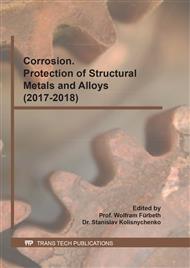[1]
A.R. Krause, H.F. Garces, G. Dwivedi, et al., Calcia-magnesia-alumino-silicate (CMAS)-induced degradation and failure of air plasma sprayed yttria-stabilized zirconia thermal barrier coatings. Acta Mater. 105 (2016) 355-366.
DOI: 10.1016/j.actamat.2015.12.044
Google Scholar
[2]
N.P. Padture, Advanced structural ceramics in aerospace propulsion, Nature Mater. 15 (2016) 804-809.
DOI: 10.1038/nmat4687
Google Scholar
[3]
L. Wang, J.I. Eldridge, S.M. Guo, Comparison of different models for the determination of the absorption and scattering coefficients of thermal barrier coatings, Acta Mater. 64 (2014) 402-410.
DOI: 10.1016/j.actamat.2013.10.053
Google Scholar
[4]
S. Mahade, N. Curry, S. Björklund et al., Functional performance of Gd2Zr2O7/YSZ multi-layered thermal barrier coatings deposited by suspension plasma spray, Surf. Coat. Technol. 318 (2017) 208-216.
DOI: 10.1016/j.surfcoat.2016.12.062
Google Scholar
[5]
H. Chen, H. Klemm, Environmental barrier coatings for silicon nitride, Key Eng. Mater. 484 (2011) 139-144.
DOI: 10.4028/www.scientific.net/kem.484.139
Google Scholar
[6]
M. Longauerová, P. Horňak, P. Zubko, Powder processing and thermal spraying of barium- magnesium-aluminium-silicate environmental barrier coatings, Key Eng. Mater. 891 (2017) 569-573.
DOI: 10.4028/www.scientific.net/msf.891.569
Google Scholar
[7]
H. Kakisawa, T. Nishimura, A new method for testing the interface toughness of ceramic environmental barrier coatings (EBCs) on ceramic matrix composites (CMCs), J. Eur. Ceram. Soc. 38 (2018) 655-663.
DOI: 10.1016/j.jeurceramsoc.2017.09.032
Google Scholar
[8]
K.M. Grant, S. Krämer, J.P.A. Löfvander, et al., CMAS degradation of environmental barrier coatings, Surf. Coat. Technol. 202 (2007) 653-657.
DOI: 10.1016/j.surfcoat.2007.06.045
Google Scholar
[9]
J. Liu, L. Zhang, Q. Liu et al., Calcium-magnesium-aluminosilicate corrosion behaviors of rare-earth disilicates at 1400 °C, J. Euro. Ceram. Soc. 33 (2013) 3419-3428.
DOI: 10.1016/j.jeurceramsoc.2013.05.030
Google Scholar
[10]
D.L. Poerschke, J.S.V. Sluytman, K.B. Wong et al., Thermochemical compatibility of ytterbia- (hafnia/silica) multilayers for environmental barrier coatings, Acta Mater. 61 (2013) 6743-6755.
DOI: 10.1016/j.actamat.2013.07.047
Google Scholar
[11]
J.S. Yang, J.H. Yu, X.H. Zhong et al., Experimental and numerical investigation of residual stresses in plasma-sprayed thermal barrier coatings, J. Inorg. Mater. 28 (2013) 1381-1386.
DOI: 10.3724/sp.j.1077.2013.13272
Google Scholar
[12]
D.L. Poerschke, D.D. Hass, S. Eustis et al., Stability and CMAS resistance of ytterbium- silicate/hafnate EBCs/TBC for SiC composites, J. Am. Ceram. Soc. 98 (2015) 278-286.
DOI: 10.1111/jace.13262
Google Scholar
[13]
S.B. Wang, Y.R. Lu, Y.X. Chen, Synthesis of single‐phase β‐Yb2Si2O7 and properties of its sintered bulk, Int. J. App. Ceram.Technol., 12 (2015) 1140-1147.
DOI: 10.1111/ijac.12353
Google Scholar
[14]
S. Mahade, N. Curry, S. Björklund et al., Thermal conductivity and thermal cyclic fatigue of multilayered Gd2Zr2O7/YSZ thermal barrier coatings processed by suspension plasma spray, Surf. Coat. Technol. 283 (2015) 329-336.
DOI: 10.1016/j.surfcoat.2015.11.009
Google Scholar
[15]
S. Ueno, T. Ohji, H.T. Lin, Recession behavior of Yb2Si2O7 phase under high speed steam jet at high temperatures, Corros. Sci. 50 (2008) 178-182.
DOI: 10.1016/j.corsci.2007.06.014
Google Scholar
[16]
T. Hussain, Cold spraying of titanium: A review of bonding mechanisms, Microstructure and Properties, Key Eng. Mater. 533 (2013) 53-90.
DOI: 10.4028/www.scientific.net/kem.533.53
Google Scholar
[17]
S.M. Ahn, S.Y. Park, Y.C. Kim et al., Surface residual stress in soda-lime glass evaluated using instrumented spherical indentation testing, J. Mater. Sci, 50 (2015) 7752-7759.
DOI: 10.1007/s10853-015-9345-x
Google Scholar
[18]
N.V. Patel, E.H. Jordan, S. Sridharan et al., Cyclic furnace testing and life predictions of thermal barrier coating spallation subject to a step change in temperature or in cycle duration, Surf. Coat. Technol. 275 (2015) 384-391.
DOI: 10.1016/j.surfcoat.2015.04.037
Google Scholar
[19]
C. Zheng, N.Q. Wu, J. Singh, Effect of Al2O3 overlay on hot-corrosion behavior of yttria-stabilized zirconia coating in molten sulfate-vanadate salt, Thin Solid Films 443 (2003) 46-52.
DOI: 10.1016/s0040-6090(03)00670-9
Google Scholar
[20]
D. M. Namara, P. Alveen, S. Damm et al., A raman spectroscopy investigation into the influence of thermal treatments on the residual stress of polycrystalline diamond, Int. J. Refract. Met. Hard Mater. 52 (2015) 114-122.
DOI: 10.1016/j.ijrmhm.2015.04.025
Google Scholar



